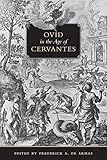Ovid in the Age of Cervantes / Frederick A. de Armas.
Material type: TextPublisher: Toronto : University of Toronto Press, [2010]Copyright date: ©2010Description: 1 online resource (320 p.)Content type:
TextPublisher: Toronto : University of Toronto Press, [2010]Copyright date: ©2010Description: 1 online resource (320 p.)Content type: - 9781442641174
- 9781442686670
- 860.9/003
- online - DeGruyter
| Item type | Current library | Call number | URL | Status | Notes | Barcode | |
|---|---|---|---|---|---|---|---|
 eBook
eBook
|
Biblioteca "Angelicum" Pont. Univ. S.Tommaso d'Aquino Nuvola online | online - DeGruyter (Browse shelf(Opens below)) | Online access | Not for loan (Accesso limitato) | Accesso per gli utenti autorizzati / Access for authorized users | (dgr)9781442686670 |
Browsing Biblioteca "Angelicum" Pont. Univ. S.Tommaso d'Aquino shelves, Shelving location: Nuvola online Close shelf browser (Hides shelf browser)

|

|

|

|

|

|

|
||
| online - DeGruyter Architectural Identities : Domesticity, Literature and the Victorian Middle Class / | online - DeGruyter The Defining Decade : Identity, Politics, and the Canadian Jewish Community in the 1960s / | online - DeGruyter Atom Egoyan's 'The Adjuster' / | online - DeGruyter Ovid in the Age of Cervantes / | online - DeGruyter Ruling by Schooling Quebec : Conquest to Liberal Governmentality - A Historical Sociology / | online - DeGruyter Partnering with Parents : Family-Centred Practice in Children's Services / | online - DeGruyter Fighting Words and Images : Representing War Across the Disciplines / |
Frontmatter -- Contents -- Preface -- PART ONE. Alternatives, Diagnoses, and Translations -- 1. A Galen for Lovers: Medical Readings of Ovid in Medieval and Early Renaissance Spain -- 2. Mythography and the Artifice of Annotation: Sánchez de Viana’s Metamorphoses (and Ovid) -- 3. Torquemada’s Ovidian Alternatives -- 4. Ovid’s Mysterious Months: The Fasti from Pedro Mexía to Baltasar Gracián -- PART TWO. Ovid and Cervantes -- 5. Ovid, Cervantes, and the Mirror: Narcissus and the Gods Transformed -- 6. Forging Modernity: Vulcan and the Iron Age in Cervantes, Ovid, and Vico -- 7. Cervantes Transforms Ovid: The Dubious Metamorphoses in Don Quijote -- PART THREE. Poetic Fables -- 8. The Mirror of Narcissus: Imaging the Self in Garcilaso de la Vega’s Second Eclogue -- 9. Circe’s Swan: The Poet, the Patron, and the Power of Bewitchment -- 10. Ovid Transformed: Cristóbal de Castillejo as Conflicted Cosmopolitan -- 11. Ovid’s ‘Hermaphroditus’ and Intersexuality in Early Modern Spain -- PART FOUR. Ovidian Fame -- 12. Ovidian Fame: Garcilaso de la Vega and Jorge de Montemayor as Orphic Voices in Early Modern Spain and the Contamino of the Orpheus and Eurydice Myth -- 13. Eros, Vates, Imperium: Metamorphosing the Metamorphoses in Mythological Court Theatre (Lope de Vega’s El Amor enamorado and Calderón’s Laurel de Apolo) -- 14. Tirso’s Counter-Ovidian Self-Fashioning: Deleitar aprovechando and the Daughters of Minyas -- 15. Noble Heirs to Apollo: Tracing African Genealogy through Ovidian Myth in Juan de Miramontes’s Armas antárticas -- Contributors -- Index
restricted access online access with authorization star
http://purl.org/coar/access_right/c_16ec
The Roman poet Ovid, author of the famous Metamorphoses, is widely considered one of the canonical poets of Latin antiquity. Vastly popular in Europe during the Renaissance and Early Modern periods, Ovid's writings influenced the literature, art, and culture in Spain's Golden Age.The book begins with examinations of the translation and utilization of Ovid's texts from the Middle Ages to the Age of Cervantes. The work includes a section devoted to the influence of Ovid on Cervantes, arguing that Don Quixote is a deeply Ovidian text, drawing upon many classical myths and themes. The contributors then turn to specific myths in Ovid as they were absorbed and transformed by different writers, including that of Echo and Narcissus in Garcilaso de la Vega and Hermaphroditus in Covarrubias and Moya. The final section of the book centers on questions of poetic fame and self-fashioning. Ovid in the Age of Cervantes is an important and comprehensive re-evaluation of Ovid's impact on Renaissance and Early Modern Spain.
Mode of access: Internet via World Wide Web.
In English.
Description based on online resource; title from PDF title page (publisher's Web site, viewed 01. Dez 2023)


